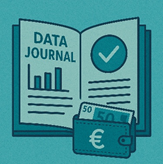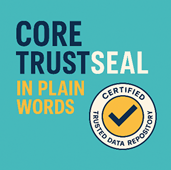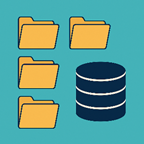
On September 30, 2025, 11:00 a.m. CEST, we will have a webinar about data journals at WiNoDa. You can find more information here. Data journals are becoming a more important way to give research data the attention and credit it deserves. But there’s one thing that people often forget: data needs to be published in a repository before it can be considered for a data journal.
And not just any old repository. The choice of repository is important to keep data safe, reusable, and reliable. The CoreTrustSeal is a community-driven certification that shows which repositories meet basic trustworthiness standards.

In this article, I talk about what CoreTrustSeal is, why so many repositories want it, and what it means for researchers in real life. Think of it as a warm-up for the webinar: the first step to understanding how data journals work is to understand repositories.
I also published a guide on how to choose the best repository for your data, which is a hands-on resource for researchers who are getting ready to share their work.
What does CoreTrustSeal mean in simple terms?
CoreTrustSeal (CTS) is a community-driven certification for digital data repositories. You can think of it as a stamp of approval. If a repository has the CoreTrustSeal, it means that a group of independent experts has looked inside and confirmed that it meets a set of basic trustworthiness standards [1]. These criteria include everything you would expect from a reliable repository, such as secure storage, good data management practices, continuity plans, and sound governance policies [2]
The Research Data Alliance started CoreTrustSeal as part of its work. A non-profit organisation runs it, and they keep it simple by only focusing on the basics and not adding too much red tape to the repositories [1]. The certification process is a self-assessment that is reviewed by peers. Repositories explain how they meet the requirements, and volunteers from the community look over the application [1]. More than 160 repositories around the world had been certified against 16 requirements by 2024 [2].

Why do repositories want to get certified?
Getting certified isn’t just a way to show off. There are a few reasons why repositories want CoreTrustSeal:
Trust and reputation: Getting CoreTrustSeal lets researchers and funders know that an outside group has checked the repository. [1]. When the Cambridge Structural Database (CSD) earned its certification, the team noted it provided “assurances of the reliability and quality of both our data stewardship and the access to data.” [6]. In Germany, the BonaRes repository [9] holds CoreTrustSeal certification to demonstrate that its soil and agricultural data are curated and preserved according to international standards.

Meeting funder requirements: A lot of journals and funders want data to be stored in “trustworthy” repositories. When the Purdue University Research Repository (PURR) received CoreTrustSeal in 2024, it was praised as ‘formal validation of compliance with federal funding agencies’ required repository characteristics.” [5]. Similarly, PANGAEA, based in Bremen, is a CoreTrustSeal-certified repository for Earth and environmental sciences [10]. As a major publisher, it uses certification to reassure funders and journals that biodiversity and environmental datasets are archived sustainably.
Internal improvement: The certification process often shows where things are missing. Repositories say that this is a chance to follow best practices and make policies stronger. [4]. As the former coordinator of the BonaRes repository, I learned a lot during the certification process and had to fill in some gaps that we became aware of only through fulfilling the 16 requirements to apply for certification. Going through the self-assessment helped us document workflows and improve backup strategies. The repository is now certified and listed.
Community recognition: Certification links repositories to a network of people all over the world. Astromaterials Data System (Astromat), which was certified in 2025, said that joining was an honor and a chance to be part of a diverse community of trusted repositories [4]. Within Germany, repositories like BonaRes and PANGAEA strengthen their position in the NFDI ecosystem while also being visible internationally.

What does it mean for researchers in real life?
For researchers, getting certified means getting a lot of practical benefits:

Data safety and accessibility: Certified repositories must have strong plans for preserving data and even for passing it on to someone else so that data won’t disappear even if the repository changes hands. [2][7]. For instance, depositing soil datasets in BonaRes or biodiversity data in PANGAEA gives researchers confidence that their work will remain accessible for decades.
Easy compliance: Depositing in a CoreTrustSeal-certified repository makes it easy to meet the needs of both funders and data journal publishers. [5][8].
Confidence in data quality: Certifying repositories check metadata and documentation, which makes datasets easier to understand and reuse [7]. This benefits, for example, ecological datasets in PANGAEA or land-use data in BonaRes, where structured metadata is critical for reuse.
Better discoverability: Certified repositories invest in persistent identifiers, search interfaces, and open metadata, which makes it more likely that people will find your dataset [7]. This matters for researchers citing data from BonaRes, PANGAEA, or other certified German repositories, as it reassures them the links will last.
Sustainability: To get certified, you have to show that your organization is stable and has plans for the future [6]. Most researchers can’t see that stability, but it matters if you want your dataset to be cited ten years from now.
Updates for 2023–2025: Keeping up with change.
Every few years, the CoreTrustSeal criteria are changed. The requirements for 2023-2025 added some important new things, like a succession plan. Repositories must show how data will stay accessible if they stop working [2]. Another goal is to make sure that repositories deal with problems like fake or low-quality data to keep trust high [2].
These changes are made by the community. Before finalizing requirements, CoreTrustSeal gets feedback from repository staff all over the world [3]. The outcome is a dynamic standard that adapts with the research environment.The next revision (2026-2028) is already being worked on [3]. Certification isn’t a one-off trophy; it’s a recurring commitment.
Conclusion
The point of CoreTrustSeal is to build trust. It’s a way for repositories to think about and improve themselves. For researchers, it’s a quiet promise that someone has checked the basics: safety, access, and sustainability.
A badge by itself doesn’t fix all problems, but the CoreTrustSeal process pushes repositories to adopt better practices, be more open, and build stronger communities. In a research world full of data, that’s a small but important step towards making sure our work stays useful and reliable over time.
And as we look forward to the WiNoDa webinar on data journals, keep in mind that data needs a safe place to live before it can shine in a journal. CoreTrustSeal and other certifications help make sure that a home is safe, visible, and long-lasting.
References
[1] CoreTrustSeal. Why get certified? https://www.coretrustseal.org/why-certification/
[2] CoreTrustSeal. Requirements for reliable data repositories (2023-2025). https://www.coretrustseal.org/why-certification/requirements/
[3] CoreTrustSeal. (April 4, 2023). Community involvement in updating requirements from 2023 to 2025. https://www.coretrustseal.org/why-certification/meeting-community-needs/trustworthy-data-repository-requirements-review-2023-2025/
[4] Astromat. (February 24, 2025). Astromat got the CoreTrustSeal certification. https://www.astromat.org/news
[5] Purdue University Libraries. (September 24, 2024). The Purdue University Research Repository gets the CoreTrustSeal. https://blogs.lib.purdue.edu/news/2024/09/24/purdue-university-research-repository-obtains-coretrustseal-approval/
[6] Cambridge Crystallographic Data Centre. (March 27, 2024). CSD CoreTrustSeal certification means that the CSD is a reliable place to store data. https://www.ccdc.cam.ac.uk/discover/blog/coretrustseal-certification-the-csd-as-a-trustworthy-data-repository/
[7] Library of the University of Edinburgh. A digital repository you can trust. Research Data Service. https://library.ed.ac.uk/research-support/research-data-service/after/data-repository/trustworthy-digital-repository.
[8] University of Cambridge. August 17, 2023. Apollo gets the CoreTrustSeal. https://unlockingresearch-blog.lib.cam.ac.uk/?p=3736
[9] BonaRes Repository, Leibniz Centre for Agricultural Landscape Research (ZALF). https://maps.bonares.de/mapapps/resources/apps/bonares
[10] PANGAEA Data Publisher for Earth & Environmental Science. https://www.pangaea.de/about/

As Knowledge Manager and Helpdesk Support at WiNoDa, I facilitate access to tools, training, and expert guidance in research data management across disciplines. With a strong background as a data steward, I support researchers in making their data FAIR, well-documented, and sustainably reusable.
https://orcid.org/0000-0001-6048-9272
